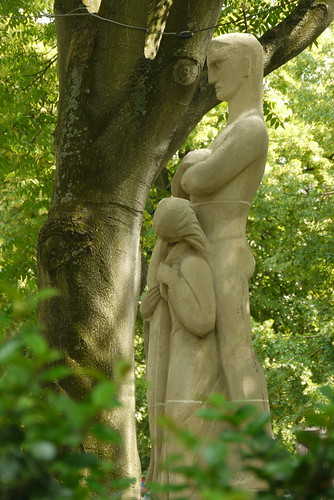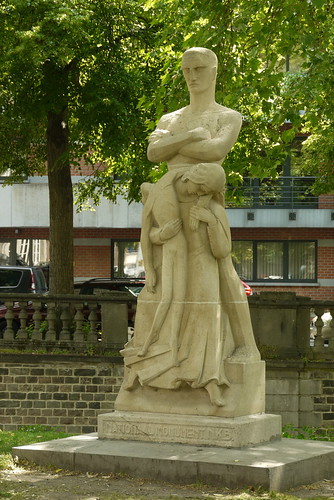Strolling along the River Dilje on our way back to Hotel Klooster I noticed the side view of this rather striking statue. The statue caught my eye because it was set off by the neighboring tree trunk which to me presents a similar profile and this intrigued me.
When I moved round to the front of the statue I found the image disturbing but I did not know what it represented. After a bit of research when I returned home I found the following information:
Stone sculpture of a woman with a dying son in her arms, overlooked by a man.
The work is one of the lesser known images of Leuven. The statue commemorates a part of the resistance movement of Leuven during World War II. The initiative came from the National Royalist Movement Leuven (NKB), and it was inaugurated on 4 October 1959. The creator Willem De Backer from Berg. He was a teacher at the Academy of Louvain between 1942 and 1970. Hence, the location of the image.
Now I know the context I think that the monument presents a powerful image. I would be interested to know your thoughts…










Most unusual indeed.
The juxtaposition of the tree and the monument was most unusual
It makes quite a statement and one I hope we don’t forget….to turn a blind eye again….but I think we continue to do this son’t we.
The statue does make a powerful statement. Sadly it seems to be part of human nature to continue the cycle of war!
Art as a form of communication is a feature of humanity. But all too often the artist is inarticulate. In this case the message is just not getting across. It looks like a brutal statement but of and about what I do not know. Is the man a thug, responsible for the woman’s pain and the boy’s death? Or is he an adamant resistor of a thuggery that caused the pain and death. Is he an indomitable spirit, protecting from further harm, grim in his determination, or an agent of evil?
I am quite au fait with the view that art should elicit thought and feeling from the viewer, but random, fractured incoherent thoughts, juxtaposed and contrary, with mixed feeling all over the place seems to me to be a failure of meaning.
It could do with a written explanation.
Like you I didn’t understand the statue when I saw it. I also did not understand the inscription on the plinth – National Monument NKB
When I got home I Googled and found this:
https://en.wikipedia.org/wiki/Mouvement_National_Royaliste
Which made me think the Belgians would probably understand the monument and that I was looking at it with English eyes and thoughts. This area of Belgium suffered greatly in WWII and I am reminded of the Kazerne Dossin which I visited last year.
https://cherryelsewhere.wordpress.com/2014/06/04/kazerne-dossin/
Whilst Googling ‘National Monument NKB’ I found the following link which I think you will like
http://www.dracomedals.com/Belgium-WW2-National-Royalist-Movement-Resistance-Military-Medal-00447.htm
Hmm – context helps, yes, but I agree perhaps more info is needed.
At first glance, the angry-looking man, strong and sculpted in symmetric proportion, is almost OUT of proportion with the other 2 disfigured/imperfect figures, and has his arms folded above them rather than towards them – so my first feeling was “this statue is about oppression of the weak by the strong.”
But on second glance, zooming in to see where he’s “looking”, correct me if I’m wrong, but it appears he’s not really “looking” down at them, he’s looking over and past them, as if at someone or something else? Also on zooming in, I noted the “angry man” almost looks disgusted as well as angry – not sure if that helps either opinion
I was reading a book not long ago called “Heretics and Heroes” which goes into detail about how artists, especially during the renaissance and reformation in Europe, often give little passive-aggressive digs to their commissioners or culture that pass through without notice for payment.
Artists, being artists, and wanting to express all they felt, had to be told several times not to take things too far (especially with unpleasantness) or risk not receiving commission funding. As we know, artists don’t much care for restrictions – so at times, they “snuck in” little clues that told us the full extent of how they felt anyway, some of the meanings of which have been lost forever in history. The result of this was often “mixed message” or an unclear message for later onlookers that we aren’t clear on.
Perhaps that is the case with this later Belgian resistance statue? Most casual onlookers never notice, Cherie, good eye – and it very well may be the artist just wasn’t a very good one – but it could be that it’s meaning was so much more than it appears but has been lost. Supersleuth Cherie on the case, however, may find it some day
Following on from my reply to Amfortas and in response to your thoughts.
I saw an angry defiant man looking out at the world but I was unsure of the two crumpled figures in front of him. What I didn’t understand at the time was why they were crumpled and they seemed disconnected from him.
Now I see in the statue the Belgian view to German oppression and the Belgian resistance to that oppression.
I think the Belgians would understand the statue, the recent history is part of their heritage.
At first I took it as the man was their oppressor,but after reading that your own research suggest that this statue is to symbolize resistance, I think the man is the woman’s husband and father of the male child, a casualty of all they resist?
I am always amazed when you give us a glimpse of your mind’s eye. The eye of an artist. That tree is perfectly placed to enhance the form of the statue. You have to wonder if it was accidental of not?
It could be the husband or it could symbolize men defending women and children by resisting the oppressor.
With my photos I show the world through my eyes
I know and I love it. Not being an artist I would never ’see’ things without your eyes guiding me.
Not being an artist I would never ’see’ things without your eyes guiding me. 